As we navigate the complexities of parenthood, we often encounter the familiar phrase, ‘I’m bored“, from our children. This simple, innocuous statement carries significant implications for a child’s mental, cognitive, and social development. But what does this statement indeed mean? Is it a call for attention, a plea for mental stimulation, or merely a momentary lack of engagement? As we unpack this ordinary childhood refrain, we invite you to join the conversation and discover the underlying layers of ‘childhood boredom,’ its impact, and the strategies to turn it into a growth opportunity.
Key Takeaways
- When a child says, ‘I’m bored,’ it often signifies a need for engagement, attention, or connection with adults.
- Childhood boredom can result from overscheduling and a lack of downtime, indicating the need to balance structured activities and free time.
- The expression of boredom can allow children to explore their creativity and personal growth, fostering independence and decision-making skills.
- Boredom in children can signify the need for physical activity, suggesting participation in outdoor sports, dance parties, or obstacle course creation.
- By stating ‘I’m bored,’ children may seek control over their environment, prompting activities like organizing their bedroom spaces or initiating yoga or fitness classes.
Understanding Childhood Boredom
The domain of childhood boredom, often misconstrued as a negative state, can catalyze increased creativity, personal growth, and self-guided exploration. Bored children usually need engagement, attention, or connection with adults. This can allow parents and caregivers to acknowledge and validate these feelings, fostering a supportive environment.
However, it’s essential to understand that childhood ennui can also stem from overscheduling, lack of downtime, and excessively structured environments. This reveals a pivotal need for balance in children’s lives, allowing for structured activities and free time. When children can experience and navigate their boredom, they are empowered to engage in self-directed activities.
The Boredom Jar Concept
Often employed as a creative solution to combat childhood ennui, the Boredom Jar concept empowers children to control their entertainment, fostering independence, decision-making, and creativity. The notion is simple yet ingenious: a container filled with slips of paper, each bearing a fun activity. When kids say, ‘I’m bored,’ they are encouraged to enter the jar and select their amusement.
This innovative approach shifts the responsibility of combating boredom from adults to children. It creates an opportunity for kids to explore their interests, promoting a sense of autonomy and self-reliance.
The following table highlights the benefits of the Boredom Jar:
| Benefits | Explanation |
|---|---|
| Independence | Kids make their own entertainment choices. |
| Decision-making | Kids learn to weigh options and make decisions. |
| Creativity | The variety of activities stimulates creative engagement. |
| Interest Exploration | Kids can discover new hobbies or passions. |
| Fun | Regardless, the result is an enjoyable activity. |
The Boredom Jar concept is a constructive tool to encourage children to take charge of their leisure time. It cultivates essential life skills while curbing the dreaded declaration, ‘I’m bored.
Activities for Active Children
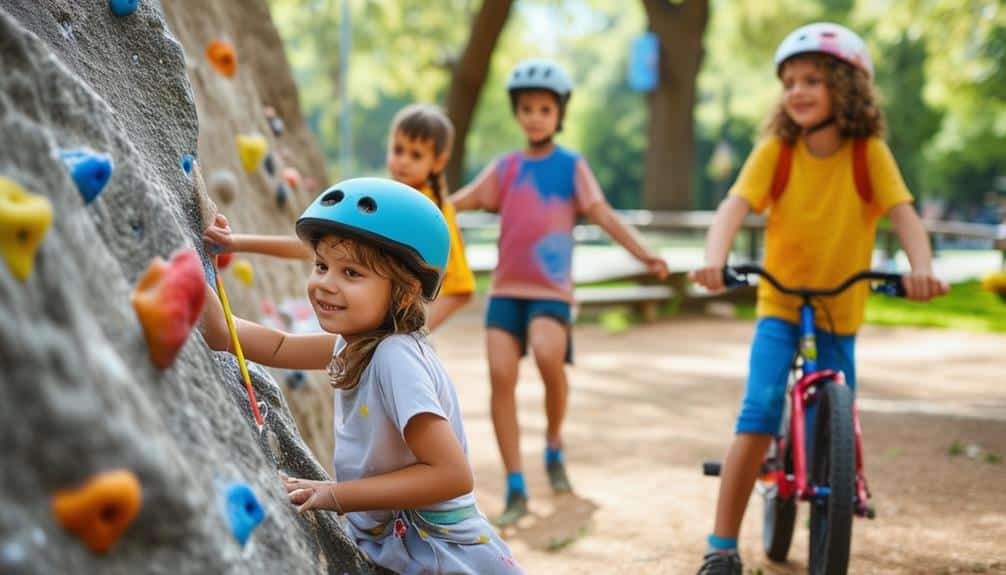
Engaging active children in physical activities, both indoors and outdoors, can address their specific needs and transform their boundless energy into a tool for overcoming boredom. When kids say, ‘I’m bored,’ we often interpret this as a lack of activities. However, active children could need more physical engagement to expend energy and stimulate their minds.
Here are some strategies for engaging active children:
- Encourage participation in outdoor sports like basketball or soccer. These games provide physical activity and foster teamwork and strategic thinking.
- Turn mundane tasks like car washing into productive and rewarding activities. This will keep them active and instill a sense of accomplishment.
- Foster exploration and curiosity by going on a bike ride around the neighborhood. This can boost their physical fitness and open them up to new experiences.
Furthermore, indoor activities like mindful movement videos can powerfully release energy and keep kids entertained. Games like hide-and-seek offer a fun and engaging way to beat boredom. Through these activities, we can effectively respond when our kids say, ‘I’m bored,’ turning their energy into productive engagement.
The Magic of Homemade Forts
When children express boredom, the imaginative world of homemade forts can offer a stimulating solution. Creating these forts enhances their creativity and provides a platform for social skill development through cooperative play. Engaging in such activities provides children a sense of adventure and autonomy, fostering their imaginative capacities while offering a cozy haven for storytelling and other forms of expressive play.
Boosting Creativity With Forts
Building homemade forts is an engaging and creative pastime that sparks children’s imaginations and cultivates vital skills such as problem-solving, spatial awareness, and motor skills. This activity, simple as it may seem, is an effective catalyst for creativity and helps children explore their abilities and potential.
When children are involved in the construction of forts, they:
- Develop problem-solving skills as they figure out how to arrange blankets, pillows, and other materials to construct stable structures.
- Enhance their spatial awareness by learning how to utilize available space effectively.
- Nurture their motor skills as they handle and manipulate various objects.
Through this process, children also learn to be independent, embracing the responsibility of designing and decorating their forts. This can significantly boost their self-confidence and self-efficacy.
Forts offer a private space for kids to engage in activities stimulating their creativity, such as pretend play, storytelling, and even quiet introspection. Moreover, these cozy retreats can also serve as comfortable spaces for reading, playing games, and simply relaxing, contributing to their comfort and security.
Social Skills in Fort-building
Fort-building fosters social skills among children and offers a unique platform for teamwork, communication, and negotiation, creating a magical world of homemade forts. In this world, children learn to cooperate and communicate effectively, essential skills that will serve them well in the future. These homemade forts become safe spaces, allowing children to express themselves freely and explore their creativity.
When your kid is engaged in fort-building, they develop problem-solving skills and spatial awareness. Planning and organizing these forts enhances their cognitive abilities, making fort-building an educational yet fun activity. Furthermore, the fort becomes a conduit for social interaction, allowing peers to engage in cooperative play.
In essence, fort-building is not merely a pastime to ward off boredom. It is a vehicle that encourages children to develop essential social and cognitive skills. The next time your child announces, ‘I’m bored,’ consider redirecting them to the magical world of fort-building. Not only will it keep them entertained, but it will also foster a plethora of skills that will aid in their overall development. The power of homemade forts is far-reaching, indeed.
Incorporating Dance Parties
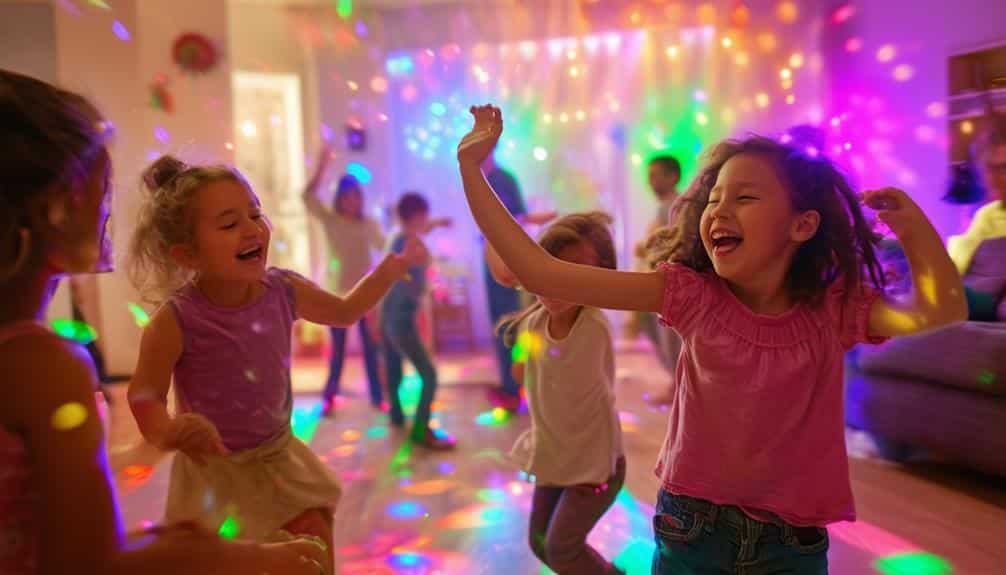
Often overlooked, dance parties serve as an engaging and active method to counteract the humdrum of boredom for children at home. When children say, ‘I’m bored,’ they often express a need for physical activity, excitement, and connection. Dance parties provide an outlet for energy and movement and a platform for creativity and expression.
A few strategies for successful dance parties at home include:
- Creating a playlist with children’s favorite songs makes the event more enjoyable and tailored to their preferences.
- We encourage physical activity by promoting freeform dance moves, which can also serve as a fun exercise form, making the dance party a family event and fostering a sense of togetherness and mutual enjoyment.
Incorporating dance parties is not merely about dispelling boredom but promoting physical health, creativity, and family bonding. Understanding and empathizing with the underlying needs expressed when a child says, ‘I’m bored,’ allows us to serve them better. Dance parties emerge as a simple yet effective solution, providing children with an engaging and uplifting activity at home.
Constructing Obstacle Courses
Constructing obstacle courses is an engaging and dynamic activity that offers multiple benefits for children, including physical activity and cognitive development. With some creativity, these courses can be designed to cater to the child’s age, space limitations, and available materials, transforming their environment into a playground. Moreover, this activity keeps kids entertained and fosters learning through problem-solving, teamwork, and imagination.
Benefits of Obstacle Courses
Obstacle courses are a beneficial tool for child engagement and physical activity. They promote creativity and stimulate problem-solving skills. When children are tasked with constructing and finding their way through obstacle courses, they can simultaneously exercise their bodies and minds.
There are several key benefits to this interactive activity:
- Physical Engagement: Obstacle courses require children to run, jump, crawl, climb, and navigate their way around, fostering physical health and agility.
- Problem-Solving Skills: As children navigate the courses, they are encouraged to think critically and creatively to overcome challenges.
- Teamwork and Collaboration: Building and overcoming these courses often involve teamwork and collaboration, promoting social skills and peer cooperation.
In a society where sedentary activities are increasingly common, obstacle courses offer a stimulating, active alternative. They ensure children remain active and engaged, reducing boredom while enhancing creativity, problem-solving skills, and social interaction. For those seeking to serve the needs and interests of children, it’s clear that obstacle courses offer substantial benefits.
Designing Creative Courses
While creating imaginative obstacle courses might appear challenging, it is an engaging and enjoyable activity that encourages physical activity and nurtures problem-solving skills and creativity among children. When children express boredom, it often signifies a need for stimulating activities that involve both the mind and body. Constructing obstacle courses can effectively address this requirement.
Constructing obstacle courses entails children strategizing, navigating, and conquering physical challenges. Older children can flex their creativity and critical thinking as they plan their courses, while toddlers may require initial guidance. This process improves children’s coordination, spatial awareness, and decision-making, preparing them for practical challenges.
Furthermore, it promotes independence as children make choices regarding the course layout, the difficulty level, and the game regulations. Children are less likely to express boredom by taking control of their entertainment.
Creating obstacle courses is a straightforward, cost-efficient way to engage children, encourage physical activity, and cultivate vital life skills. It is a valuable resource for parents, educators, and individuals committed to meeting children’s developmental requirements.
Kids’ Engagement and Learning
Through the lens of child development, building obstacle courses emerges as a compelling method to engage and educate kids, fostering physical fitness and a plethora of cognitive skills such as problem-solving and strategic thinking. Engaging a child in constructing obstacle courses can effectively counter the frequent ‘I’m bored’ statement, offering them an interactive and stimulating activity that caters to their natural curiosity and adventurous spirit.
Constructing obstacle courses can:
- Foster creativity and adaptability as children design and modify the layout based on their capabilities and preferences.
- Enhance communication and teamwork skills when children collaborate on planning and executing the course.
- Boost confidence and resilience as children overcome challenges and celebrate their accomplishments.
This multi-faceted approach to engagement and learning is an antidote to boredom, simultaneously fostering physical agility, cognitive development, and social skills. Indeed, when a child says, ‘I’m bored,’ it might be an opportunity to introduce them to the engaging world of constructing obstacle courses. This world encourages learning, growth, and, most importantly, fun.
Organizing Bedroom Spaces
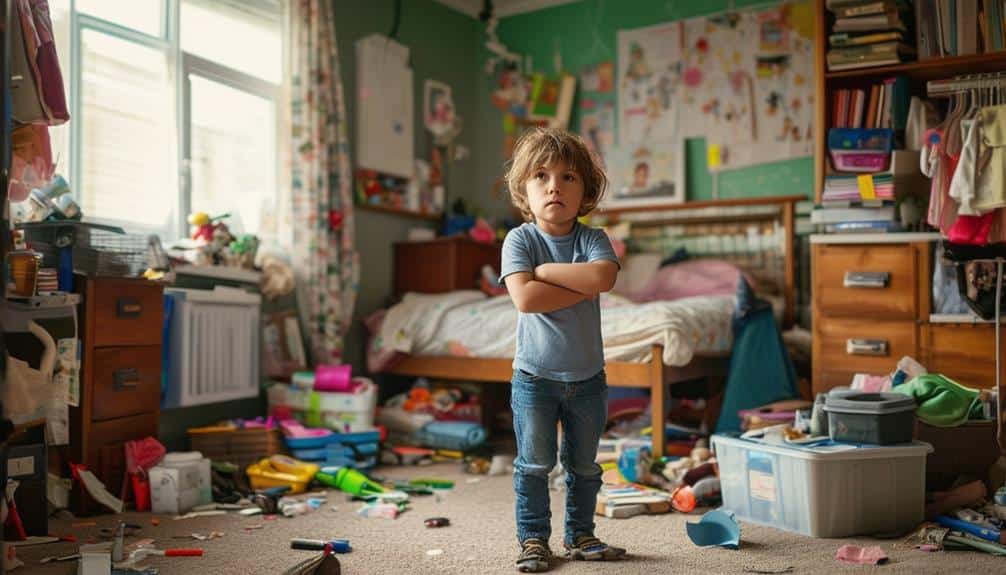
Undeniably, organizing bedroom spaces plays a crucial role in providing children with a sense of control and reducing unnecessary mess. When children say, ‘I’m bored,’ it can sometimes be a manifestation of feeling overwhelmed by disarray in their private space. Creating a well-ordered environment can thus be a therapeutic and empowering response.
Organizing a child’s bedroom does not merely entail a tidy room but promotes a sense of calmness and relaxation essential for quality sleep. Additionally, it prepares them for future responsibilities by fostering a sense of ownership.
Table 1 below illustrates the benefits of keeping a tidy room:
| Benefits | Short term | Long term |
|---|---|---|
| Sense of control | Immediate satisfaction | Development of responsibility |
| Reduced mess | More play space | Enhanced focus and productivity |
| Promotes calmness | Better sleep quality | Improved overall well-being |
To conclude, decluttering and rearranging furniture can transform a child’s bedroom into a more functional and visually appealing space, positively affecting their well-being. This approach can be an effective solution when children say, ‘I’m bored,’ offering them both physical and psychological benefits that extend beyond the initial act of tidying up.
Initiating Yoga or Fitness Classes
Introducing yoga or fitness classes may offer significant physical and mental benefits when a child expresses boredom. This choice addresses their need for activity and cultivates a habit that boosts health, flexibility, and overall well-being. The key lies in selecting age-appropriate online classes and fostering a routine of regular practice, transforming their boredom into a productive and enjoyable fitness journey.
Benefits of Child Yoga
Remarkably, child yoga classes not only offer an outlet for children to release energy and promote relaxation, but they also foster significant enhancements in their physical health and flexibility. These classes encourage children to stay active indoors, providing an exercise regimen that is suitable for all ages and fitness levels.
In addition to the physical benefits, yoga fosters mindfulness and concentration in children. This is especially important as it enhances their overall well-being and mental clarity, leading to better performance in their academic and social lives.
Child yoga classes offer a range of benefits, including:
- The improvement of self-esteem and body awareness promotes a positive body image. This often results in children developing a healthy relationship with their bodies, leading to improved self-confidence.
- Yoga reduces stress and anxiety levels by providing a fun and interactive way for children to connect with their bodies and understand their emotions.
- Promoting discipline and concentration are essential skills that can be applied to various aspects of a child’s life.
Therefore, child yoga is a solution to boredom and a powerful tool for holistic child development.
Selecting Suitable Online Classes
In the digital age, choosing appropriate online classes like yoga or fitness for children offers a unique opportunity not to combat monotony and promote physical health, flexibility, and overall well-being. As caregivers or professionals serving children, we must acknowledge the importance these classes bring, providing an engaging, fun, and interactive way for children who frequently express ‘I’m bored’ to channel their energy and focus.
Online yoga or fitness classes are tailored to meet the needs of all ages and fitness levels, making them an inclusive solution to children’s diverse requirements. These classes can offer an exhilarating platform for children to release energy and unwind, thus establishing a balance vital for their growth and development.
When faced with the phrase ‘I’m bored,’ these classes are an efficient tool to motivate children to remain active and maintain a healthy lifestyle indoors. Additionally, they can significantly contribute to children’s physical health and flexibility. Consequently, choosing appropriate online classes becomes crucial in creating a stimulating environment supporting children’s well-being.
Encouraging Regular Fitness Practice
Understanding the significant benefits of online yoga or fitness classes for children, it becomes imperative to encourage regular practice and foster an active lifestyle from a young age. Regular engagement in yoga or fitness helps children release pent-up energy, cultivates a sense of calmness, and improves physical health. Online platforms offer the flexibility of various programs catering to different ages and fitness levels, making it accessible and enjoyable for all children.
It’s important to remember:
- These practices have the inherent value of promoting relaxation, improving flexibility, and instilling an appreciation for physical activity.
- These online classes provide a fun, structured, and safe way for children to exercise, fostering their overall well-being.
- Encouraging this practice from a young age can help children form a habit and maintain a healthy lifestyle into adulthood.
Engaging in Lego Hunts
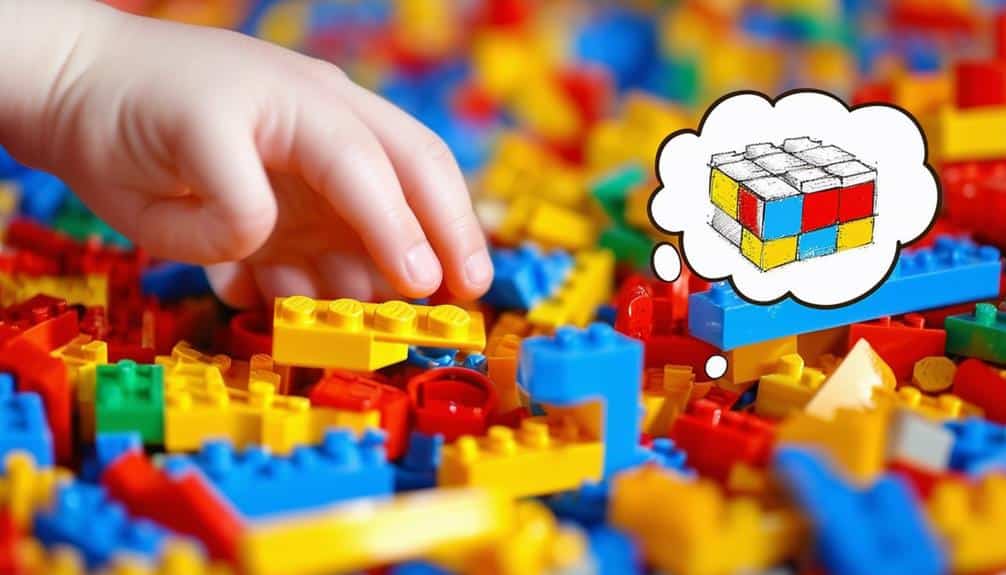
Delving into the world of Lego searches offers children a unique opportunity to enhance their problem-solving skills and critical thinking while fostering collaboration and teamwork. This innovative approach to keeping them engaged becomes an antidote to the common phrase, ‘I’m bored.’
Lego searches involve hiding and finding matching Lego blocks. They are enjoyable activities and a platform to boost children’s visual and spatial skills. The thrill of discovery and the joy of accomplishment they experience when finding a Lego piece enhance their self-esteem and create a sense of achievement.
Incorporating painting and hiding rocks into Lego searches can provide an artistic outlet, further engaging children’s imaginative faculties. This fusion of art and play fosters a creative environment conducive to children’s holistic development.
Moreover, the outdoor exploration that Lego searches encourage aids in developing a healthy connection with nature. Children are naturally curious, and the outdoors provides a broad canvas for their minds. Indeed, Lego searches offer an engaging way for children to express their creativity and keep boredom at bay. It is a valuable tool that transforms the mundane into an exciting learning adventure.
The Art of Scavenger Hunts
Scavenger hunts are engaging and versatile activities that stimulate children’s problem-solving skills and creativity by transforming their immediate environment, be it indoors or outdoors, into a playground for exploration. When a child says, ‘I’m bored,’ it could indicate a desire for more challenging and immersive experiences. The art of scavenger hunts meets this need by offering a rich blend of active learning and fun.
Scavenger hunts are designed to:
- Promote observation and critical thinking as children search for hidden items or clues
- Foster teamwork and collaboration among participants
- Spark creativity through the process of decoding hints and discovering treasures
Scavenger hunts’ adaptability allows them to be tailored to any setting, making them ideal solutions for moments when children express feelings of boredom. Parents or older siblings can easily organize these activities, providing a stimulating and entertaining experience for children of all ages. Not only do scavenger hunts keep children engaged, but they also contribute to their cognitive development. Ultimately, the art of scavenger hunts is an effective antidote to the recurring childhood complaint: ‘I’m bored.’
Frequently Asked Questions
How to Respond When a Child Says I’m Bored?
When a child expresses boredom, it’s an opportunity to foster creativity and independence. Validate their feelings, encourage them to problem-solve, and suggest they refer to a pre-prepared activity list, promoting initiative and imagination.
What Causes a Child to Be Bored?
Various factors can cause a child to be bored, including lack of engagement, overscheduling, or a need for attention. By understanding these reasons, we can effectively address their needs and promote healthier, more stimulating environments.
When a Student Says They Are Bored?
When a student expresses boredom, it’s often a signal of disengagement or lack of motivation. This can stem from uninteresting tasks, challenging material, or sentimental factors. It’s vital to understand and address these underlying issues.
Is My Child Bored or ADHD?
Determining if a child is merely bored or has ADHD requires professional evaluation. ADHD involves consistent patterns of inattention, hyperactivity, and spontaneous behavior. Boredom alone doesn’t constitute ADHD. Consult a healthcare professional for accurate diagnosis and support.
Conclusion
Understanding a child’s complaints of boredom is critical to fostering their mental well-being and creativity. Countless parents can use activities like the Boredom Jar, DIY forts, and scavenger hunts to help their kids explore their passions. These age-appropriate options keep your child happy and promote self-reliance and creativity during unstructured time.
Activities like dance celebrations, bedroom decluttering, and yoga provide great at-the-ready options for kids. These activities help balance organized and unstructured time, supporting their overall growth. Incorporating basic activities and board games can transform screen time into creative time, making daily routines more engaging and fun for everyone.
Parents can turn boredom blues into opportunities for growth by paying attention to boredom. Encouraging constructive boredom with various activities helps children develop a sense of identity and crucial life skills. These positive parenting solutions keep kids entertained and prepare them for life’s challenges, ensuring they become intelligent, well-rounded individuals.

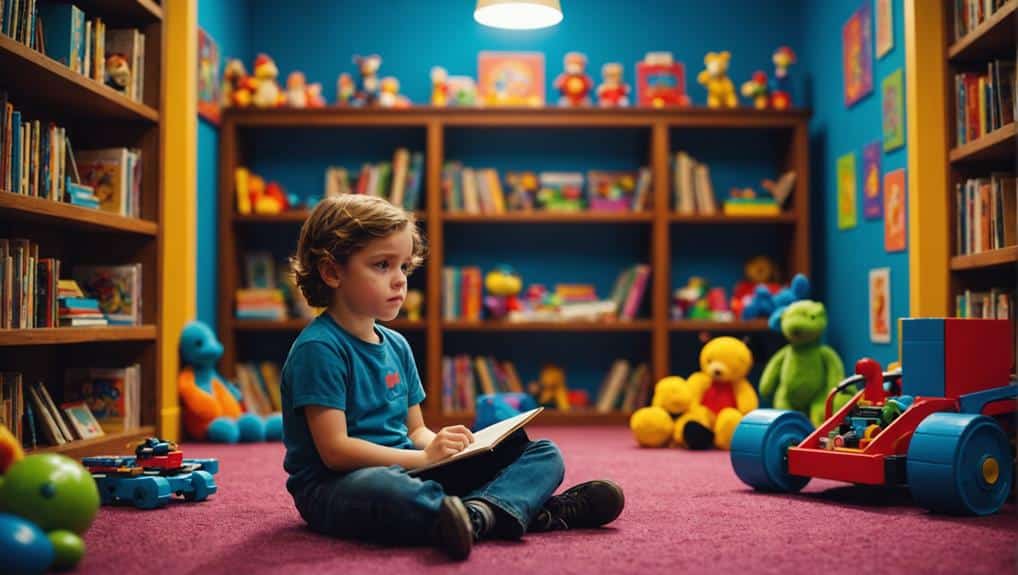
Recent Comments